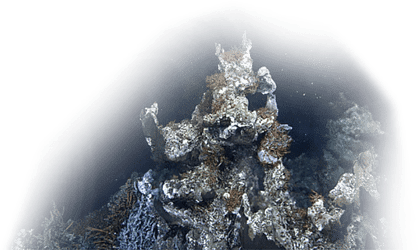A peak of more than 200 earthquakes per hour were detected this week at a deep sea site within Ocean Network Canada’s northeast Pacific seafloor observatory, the highest rate of earthquakes observed in this region since 2005.
On March 6, 2024, ONC’s real time monitoring network detected significant tectonic activity including an approximately 4.1 magnitude earthquake at the North-East Pacific Time-series Undersea Networked Experiments (NEPTUNE) observatory’s Endeavour site, at a depth of approximately 5 kilometres and 240 kilometres offshore of Vancouver Island. Increased earthquake rates have been observed at the site since 2018, with the March 6 peak swarm following several days of increased small earthquake frequency.
ONC’s NEPTUNE observatory recorded more than 200 earthquakes including a magnitude 4.1 at its Endeavour site on March 6, 2024. The pink triangles show the locations of ONC seismometers, which were used to determine the earthquake hypocentres. The red lines show the seafloor cables which connect to our instruments. The orange lines show the trace of the main faults within the Endeavour Segment.
The spike of earthquake activity at the Endeavour segment of the Juan de Fuca Ridge could be a sign of an “impending magmatic rupture” - a natural phenomena that can form new ocean floor, according to Zoe Krauss, a marine seismology PhD candidate at the University of Washington.
As tectonic plates pull apart, cracks form on the seafloor and are filled periodically by 800 degree celcius magma rising from deep beneath the Earth’s crust. The intense heat from the magma cools rapidly once in contact with the cold seawater and solidifies into new oceanic crust. This cyclic process occurs in “bursts” and at Endeavour, researchers expect this event to happen roughly every 20 years.
”No one should be alarmed about this great swarm of earthquakes. They are far offshore and cause no danger. Rather, the data are exciting to the science community and certainly not menacing,” says Kate Moran, ONC President and CEO.
Spectrogram generated from hydrophone data showing seismic activity at Endeavour.
“We can use earthquake activity to track the level of built-up stress at the Endeavour segment in real-time using seismic data provided by Ocean Networks Canada. More earthquakes mean more stress build-up,” says Zoe Krauss, “the NEPTUNE observatory dataset has allowed us to observe significant increases in earthquake rates over the last few years.”
ONC’s NEPTUNE observatory will allow researchers to monitor and record data from the rupture of the Endeavour segment in near real-time. “Having a whole suite of instrumentation as opposed to just seismometers allows us to immediately see what else was going on, like temperature changes inside a black smoker, or instruments starting to tilt, or listen via hydrophones if there was any hissing or tumbling from lava breaching the seafloor should that happen,” says Martin Scherwath, ONC senior scientist. Observation of the last known rupture event in 2005 relied on battery powered autonomous seafloor seismometers.
Implications for Endeavour’s biology
ONC’s Endeavour monitoring site is within the Endeavour Hydrothermal Vents Marine Protected Area (MPA), well-known for its large hot smoking chimneys and diverse biodiversity ranging from tubeworms and crabs to microorganisms like bacteria. Underwater earthquakes can not only topple existing sulfide towers, but also alter the way fluids travel beneath vent systems, changing the chemistry and temperature of the vent. This can lead to communities being displaced and reorganized. Although not expected at Endeavour, if magma breaches the seafloor, pillow lava may pave over existing vent structures, much like the Hawaiin seafloor.
This summer, ONC will be partnering with Ocean Exploration Trust to perform maintenance on the offshore NEPTUNE observatory, providing an opportunity to observe the impact of this tectonic event on the seafloor and nearby hydrothermal vents.
